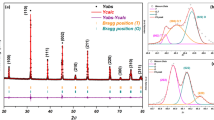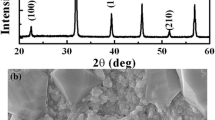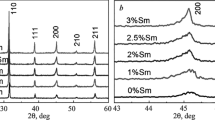Abstract
Structural, dielectric, ferroelectric, energy storage properties, and electrocaloric effect were studied in lead-free ceramic Ba0.95Ca0.05Ti0.89Sn0.11O3 (BCTSn) elaborated by the sol–gel method. Phase purity structure was confirmed from X-ray data using the Rietveld refinement analysis which revealed the coexistence of tetragonal (P4mm) and orthorhombic (Amm2) symmetries at room temperature. Phase transitions were detected by dielectric and differential scanning calorimetry measurements. The energy storage properties were determined from P-E hysteresis, and the electrocaloric properties were calculated indirectly via the Maxwell approach. The large value of electrocaloric temperature change of ΔT = 0.807 K obtained at a relatively small electric field of 30 kV cm−1, and the high energy storage efficiency can make BCTSn ceramic a promising candidate for environmentally friendly refrigeration and energy storage applications.









Similar content being viewed by others
Data availability
Not applicable.
Code availability
Not applicable.
References
A.S. Mischenko, Giant electrocaloric effect in thin-film PbZr09.5Ti0.a05O3. Science 311(5765), 1270–1271 (2006). https://doi.org/10.1126/science.1123811
B. Lu et al., Large electrocaloric effect in relaxor ferroelectric and antiferroelectric lanthanum doped lead zirconate titanate ceramics. Sci. Rep. 7(1), 45335 (2017). https://doi.org/10.1038/srep45335
M. Maraj, W. Wei, B. Peng, W. Sun, Dielectric and energy storage properties of Ba(1–x)CaxZryTi(1−y)O3 (BCZT): a review. Materials 12(21), 3641 (2019). https://doi.org/10.3390/ma12213641
J. Tušek, K. Engelbrecht, D. Eriksen, S. Dall’Olio, J. Tušek, N. Pryds, A regenerative elastocaloric heat pump. Nat. Energy 1(10), 16134 (2016). https://doi.org/10.1038/nenergy.2016.134
R.A. Bucur, I. Badea, A.I. Bucur, S. Novaconi, Dielectric, ferroelectric and piezoelectric proprieties of GdCoO3 doped (K0.5Na0.5)NbO3. J. Alloys Compd. 630, 43–47 (2015). https://doi.org/10.1016/j.jallcom.2015.01.030
L.-Q. Cheng, J.-F. Li, A review on one dimensional perovskite nanocrystals for piezoelectric applications. J. Materiomics 2(1), 25–36 (2016). https://doi.org/10.1016/j.jmat.2016.02.003
H. Zaitouni et al., Direct electrocaloric, structural, dielectric, and electric properties of lead-free ferroelectric material Ba0.9Sr0.1Ti1-xSnxO3 synthesized by semi-wet method. Phys. B Condens. Matter 566, 55–62 (2019). https://doi.org/10.1016/j.physb.2019.04.026
Y. Zhang et al., Effects of silica coating on the microstructures and energy storage properties of BaTiO 3 ceramics. Mater. Res. Bull. 67, 70–76 (2015). https://doi.org/10.1016/j.materresbull.2015.01.056
M. Acosta et al., BaTiO3 -based piezoelectrics: Fundamentals, current status, and perspectives. Appl. Phys. Rev. 4(4), 041305 (2017). https://doi.org/10.1063/1.4990046
Q. Lou et al., Ferroelectric properties of Li-doped BaTiO3 ceramics. J. Am. Ceram. Soc. 101(8), 3597–3604 (2018). https://doi.org/10.1111/jace.15480
D. Fu, M. Itoh, S. Koshihara, T. Kosugi, S. Tsuneyuki, Anomalous phase diagram of ferroelectric (Ba, Ca) TiO3 single crystals with giant electromechanical response. Phys. Rev. Lett. 100(22), 227601 (2008). https://doi.org/10.1103/PhysRevLett.100.227601
Y. Yao et al., Large piezoelectricity and dielectric permittivity in BaTiO 3–xBaSnO 3 system: the role of phase coexisting. EPL 98(2), 27008 (2012). https://doi.org/10.1209/0295-5075/98/27008
N. Horchidan et al., Multiscale study of ferroelectric–relaxor crossover in BaSnxTi1−xO3 ceramics. J. Eur. Ceram. Soc. 34(15), 3661–3674 (2014). https://doi.org/10.1016/j.jeurceramsoc.2014.06.005
D. Fu, M. Itoh, Role of Ca off-centering in tuning ferroelectric phase transitions in Ba(Zr, Ti)O3 system, in Ferroelectric materials—synthesis and characterization. ed. by A. Peláiz-Barranco (InTech, London, 2015)
X. Wang, H. Yamada, C.-N. Xu, Large electrostriction near the solubility limit in BaTiO3–CaTiO3 ceramics. Appl. Phys. Lett. 86(2), 022905 (2005). https://doi.org/10.1063/1.1850598
W. Liu, L. Cheng, S. Li, Prospective of (BaCa)(ZrTi)O3 lead-free piezoelectric ceramics. Curr. Comput.-Aided Drug Des. 9(3), 179 (2019). https://doi.org/10.3390/cryst9030179
W. Liu, X. Ren, Large piezoelectric effect in Pb-free ceramics. Phys. Rev. Lett. 103(25), 257602 (2009). https://doi.org/10.1103/PhysRevLett.103.257602
D. Damjanovic, A morphotropic phase boundary system based on polarization rotation and polarization extension. Appl. Phys. Lett. 97(6), 062906 (2010). https://doi.org/10.1063/1.3479479
X. Wang et al., Giant electrocaloric effect in lead-free Ba0.94 Ca0.06 Ti1−x Snx O3 ceramics with tunable curie temperature. Appl. Phys. Lett. 107, 252905 (2015). https://doi.org/10.1063/1.4938134
L.-F. Zhu et al., Phase transition and high piezoelectricity in (Ba, Ca)(Ti1–x Snx )O3 lead-free ceramics. Appl. Phys. Lett. 103(7), 072905 (2013). https://doi.org/10.1063/1.4818732
S. Merselmiz et al., Thermal-stability of the enhanced piezoelectric, energy storage and electrocaloric properties of a lead-free BCZT ceramic. RSC Adv. 11(16), 9459–9468 (2021). https://doi.org/10.1039/D0RA09707A
Z. Hanani et al., Thermally-stable high energy storage performances and large electrocaloric effect over a broad temperature span in lead-free BCZT ceramic. RSC Adv. 10(51), 30746–30755 (2020). https://doi.org/10.1039/D0RA06116F
P. Kantha et al., Effect of sintering method on the microstructure and dielectric properties of lead-free BCZT ceramics. Appl. Mech. Mater. 866, 263–266 (2017)
V.S. Puli et al., Structure, dielectric, ferroelectric, and energy density properties of (1–x)BZT–xBCT ceramic capacitors for energy storage applications. J. Mater. Sci. 48(5), 2151–2157 (2013). https://doi.org/10.1007/s10853-012-6990-1
Z. Wang et al., Synthesis, structure, dielectric, piezoelectric, and energy storage performance of (Ba0.85Ca0.15)(Ti0.9Zr0.1)O3 ceramics prepared by different methods. J. Mater. Sci. Mater. Electron. 27(5), 5047–5058 (2016). https://doi.org/10.1007/s10854-016-4392-x
R. Pramanik, M.K. Sahukar, Y. Mohan, B. Praveenkumar, S.R. Sangawar, A. Arockiarajan, Effect of grain size on piezoelectric, ferroelectric and dielectric properties of PMN-PT ceramics. Ceram. Int. 45(5), 5731–5742 (2019). https://doi.org/10.1016/j.ceramint.2018.12.039
S. Ben Moumen et al., Structural, dielectric and magnetic studies of (0–3) type multiferroic (1–x) BaTi0.8Sn0.2O3–(x) La0.5Ca0.5MnO3 (0 ≤ x ≤ 1) composite ceramics. J. Mater. Sci. Mater. Electron. 31(21), 19343–19354 (2020). https://doi.org/10.1007/s10854-020-04468-3
Z. Cai, X. Wang, W. Hong, B. Luo, Q. Zhao, L. Li, Grain-size–dependent dielectric properties in nanograin ferroelectrics. J. Am. Ceram. Soc. 101(12), 5487–5496 (2018). https://doi.org/10.1111/jace.15803
S. Kumari, A. Kumar, V. Kumar, Thermal and structural characterization of Bi and Cu Co-doped BCZT (AIP Publishing LLC, NY, 2020), p. 030012
P. Mishra, P. Kumar, Effect of sintering temperature on dielectric, piezoelectric and ferroelectric properties of BZT–BCT 50/50 ceramics. J. Alloys Compd. 545, 210–215 (2012). https://doi.org/10.1016/j.jallcom.2012.08.017
H. Mezzourh et al., Enhancing the dielectric, electrocaloric and energy storage properties of lead-free Ba0.85Ca0.15Zr0.1Ti0.9O3 ceramics prepared via sol-gel process. Phys. B Condens. Matter 603, 412760 (2021). https://doi.org/10.1016/j.physb.2020.412760
M. Chen et al., Enhanced piezoelectricity in broad composition range and the temperature dependence research of (Ba1−xCax)(Ti0.95Sn0.05)O3 piezoceramics. Phys. B Condens. Matter 433, 43–47 (2014). https://doi.org/10.1016/j.physb.2013.10.014
S. Belkhadir et al., Impedance spectroscopy analysis of the diffuse phase transition in lead-free (Ba0,85Ca0,15)(Zr0.1Ti0.9)O3 ceramic elaborated by sol-gel method. Superlattices Microstruct. 127, 71–79 (2019). https://doi.org/10.1016/j.spmi.2018.03.009
B. Asbani et al., Structural, dielectric and electrocaloric properties in lead-free Zr-doped Ba0.8Ca0.2TiO3 solid solution. Solid State Commun. 237–238, 49–54 (2016). https://doi.org/10.1016/j.ssc.2016.04.001
L. Zhao, B.-P. Zhang, P.-F. Zhou, L.-F. Zhu, J.-F. Li, Effect of Li2O addition on sintering and piezoelectric properties of (Ba, Ca)(Ti, Sn)O3 lead-free piezoceramics. J. Eur. Ceram. Soc. 35(2), 533–540 (2015). https://doi.org/10.1016/j.jeurceramsoc.2014.08.042
Z. Zhao et al., Grain-size effects on the ferroelectric behavior of dense nanocrystalline BaTiO 3 ceramics. Phys. Rev. B 70(2), 024107 (2004). https://doi.org/10.1103/PhysRevB.70.024107
I.A. Santos, J.A. Eiras, Phenomenological description of the diffuse phase transition in ferroelectrics. J. Phys. Condens. Matter 13(50), 11733–11740 (2001). https://doi.org/10.1088/0953-8984/13/50/333
S. Hunpratub, S. Maensiri, P. Chindaprasirt, Synthesis and characterization of Ba0.85Ca0.15Ti0.9Zr0.1O3 ceramics by hydrothermal method. Ceram. Int. 40(8), 13025–13031 (2014). https://doi.org/10.1016/j.ceramint.2014.04.166
V.S. Puli et al., Observation of large enhancement in energy-storage properties of lead-free polycrystalline 0.5BaZr0.2 Ti0.8 O3–0.5Ba0.7 Ca0.3 TiO3 ferroelectric thin films. J. Phys. Appl. Phys. 52(25), 255304 (2019). https://doi.org/10.1088/1361-6463/ab161a
L.-F. Zhu, B.-P. Zhang, L. Zhao, J.-F. Li, High piezoelectricity of BaTiO3–CaTiO3–BaSnO3 lead-free ceramics. J. Mater. Chem. C 2(24), 4764–4771 (2014). https://doi.org/10.1039/C4TC00155A
W. Cai et al., Synergistic effect of grain size and phase boundary on energy storage performance and electric properties of BCZT ceramics. J. Mater. Sci. Mater. Electron. 31(12), 9167–9175 (2020). https://doi.org/10.1007/s10854-020-03446-z
S. Merselmiz et al., High energy storage efficiency and large electrocaloric effect in lead-free BaTi0.89Sn0.11O3 ceramic. Ceram. Int. 46(15), 23867–23876 (2020). https://doi.org/10.1016/j.ceramint.2020.06.163
D. Zhan, Q. Xu, D.-P. Huang, H.-X. Liu, W. Chen, F. Zhang, Contributions of intrinsic and extrinsic polarization species to energy storage properties of Ba 0.95 Ca 0.05 Zr 0.2 Ti 0.8 O 3 ceramics. J. Phys. Chem. Solids 114, 220–227 (2018). https://doi.org/10.1016/j.jpcs.2017.10.038
D. Fu, M. Itoh, S. Koshihara, Crystal growth and piezoelectricity of BaTiO3–CaTiO3 solid solution. Appl. Phys. Lett. 93(1), 012904 (2008). https://doi.org/10.1063/1.2956400
Z. Luo et al., Enhanced electrocaloric effect in lead-free BaTi1–xSnxO3 ceramics near room temperature. Appl. Phys. Lett. 105(10), 102904 (2014). https://doi.org/10.1063/1.4895615
C. Zhao, J. Yang, Y. Huang, X. Hao, J. Wu, Broad-temperature-span and large electrocaloric effect in lead-free ceramics utilizing successive and metastable phase transitions. J. Mater. Chem. A 7(44), 25526–25536 (2019). https://doi.org/10.1039/C9TA10164K
M. Sanlialp, C. Molin, V.V. Shvartsman, S. Gebhardt, D.C. Lupascu, Modified differential scanning calorimeter for direct electrocaloric measurements. IEEE Trans. Ultrason. Ferroelectr. Freq. Control 63(10), 1690–1696 (2016). https://doi.org/10.1109/TUFFC.2016.2592542
A. Pramanick et al., Stabilization of polar nanoregions in Pb-free ferroelectrics. Phys. Rev. Lett. 120(20), 207603 (2018). https://doi.org/10.1103/PhysRevLett.120.207603
M. Sanlialp et al., Direct measurement of electrocaloric effect in lead-free Ba(SnxTi1–x )O 3 ceramics. Appl. Phys. Lett. 111(17), 173903 (2017). https://doi.org/10.1063/1.5001196
Y. Liu, J.F. Scott, B. Dkhil, Some strategies for improving caloric responses with ferroelectrics. APL Mater. 4(6), 064109 (2016). https://doi.org/10.1063/1.4954056
Y. Bai, X. Han, L. Qiao, Optimized electrocaloric refrigeration capacity in lead-free (1–x)BaZr0.2Ti0.8 O3–xBa0.7Ca0.3TiO3 ceramics. Appl. Phys. Lett. 102(25), 254 (2013). https://doi.org/10.1063/1.4810916
S.K. Upadhyay, I. Fatima, V.R. Reddy, Study of electrocaloric effect in Ca and Sn co-doped BaTiO 3 ceramics. Mater. Res. Express 4(4), 046303 (2017). https://doi.org/10.1088/2053-1591/aa6694
M. Abdessalem, I. Kriaa, A. Aydi, N. Abdelmoula, Large electrocaloric effect in lead-free Ba1-xCaxTi1-yZryO3 ceramics under strong electric field at room-temperature. Ceram. Int. 44(12), 13595–13601 (2018). https://doi.org/10.1016/j.ceramint.2018.04.194
B. Li, W.J. Ren, X.W. Wang et al., Combined effects of diffuse phase transition and microstructure on the electrocaloric effect in Ba1−x SrxTiO3 ceramics. Appl. Phys. Lett. 103(16), 162902 (2013). https://doi.org/10.1063/1.4825266
X.Q. Liu, T.T. Chen, Y.J. Wu, X.M. Chen, Enhanced electrocaloric effects in spark plasma-sintered Ba0.65 Sr0.35TiO3–based ceramics at room temperature. J. Am. Ceram. Soc. 96(4), 1021–1023 (2013). https://doi.org/10.1111/jace.12219
R. Kumar, A. Kumar, S. Singh, Large electrocaloric response and energy storage study in environmentally friendly (1–x)K0.5Na0.5NbO3–xLaNbO3 nanocrystalline ceramics. Sustain. Energy Fuels 2(12), 2698–2704 (2018). https://doi.org/10.1039/C8SE00276B
Acknowledgements
The authors gratefully acknowledge the generous financial support of CNRST Priority Program PPR 15/2015, the European Union’s Horizon 2020 research, and the Ministry of education and science of the Russian Federation Project #13.2251.21.0042.
Funding
CNRST Priority Program PPR 15/2015; The European Union’s Horizon 2020 research; Ministry of Science and Higher Education of the Russian Federation, Grant Agreement No. 075-15-2021-953.
Author information
Authors and Affiliations
Corresponding author
Ethics declarations
Conflict of interest
Not applicable.
Ethical approval
Not applicable.
Consent to participate
We confirm that all authors mentioned in the manuscript have participated in, read and approved the manuscript and have given their consent for the submission and subsequent publication of the manuscript.
Consent for publication
We confirm that all the authors mentioned in the manuscript have agreed to publish this paper.
Additional information
Publisher's Note
Springer Nature remains neutral with regard to jurisdictional claims in published maps and institutional affiliations.
Rights and permissions
About this article
Cite this article
Hadouch, Y., Ben Moumen, S., Mezzourh, H. et al. Electrocaloric effect and high energy storage efficiency in lead-free Ba0.95Ca0.05Ti0.89Sn0.11O3 ceramic elaborated by sol–gel method. J Mater Sci: Mater Electron 33, 2067–2079 (2022). https://doi.org/10.1007/s10854-021-07411-2
Received:
Accepted:
Published:
Issue Date:
DOI: https://doi.org/10.1007/s10854-021-07411-2




